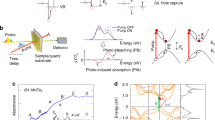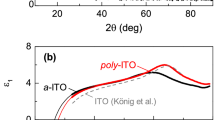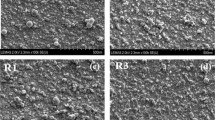Abstract
Nanoparticle films have become a promising low-cost, high-surface-area electrode material for solar cells and solar fuel production1,2. Compared to sintered nanoparticle films, oriented polycrystalline titania nanotubes offer the advantage of directed electron transport, and are expected to have higher electron mobility3,4,5,6,7. However, macroscopic measurements have revealed their electron mobility to be as low as that of nanoparticle films8,9. Here, we show, through time-resolved terahertz spectroscopy10, that low mobility in polycrystalline TiO2 nanotubes is not due to scattering from grain boundaries or disorder-induced localization as in other nanomaterials11,12, but instead results from a single sharp resonance arising from exciton-like trap states. If the number of these states can be lowered, this could lead to improved electron transport in titania nanotubes and significantly better solar cell performance.
This is a preview of subscription content, access via your institution
Access options
Subscribe to this journal
Receive 12 print issues and online access
$259.00 per year
only $21.58 per issue
Buy this article
- Purchase on Springer Link
- Instant access to full article PDF
Prices may be subject to local taxes which are calculated during checkout




Similar content being viewed by others
References
O'Regan, B. & Grätzel, M. A. Low-cost, high-efficiency solar cell based on dye-sensitized colloidal TiO2 films. Nature 353, 737–740 (1991).
Gratzel, M. Photoelectrochemical cells. Nature 414, 338–344 (2001).
Kopidakis, N. et al. Temperature dependence of the electron diffusion coefficient in electrolyte-filled TiO2 nanoparticle films: evidence against multiple trapping in exponential conduction-band tails. Phys. Rev. B 73, 045326 (2006).
Varghese, O. K., Paulose, M. & Grimes, C. A. Long vertically aligned titania nanotubes on transparent conducting oxide for highly efficient solar cells. Nature Nanotech. 4, 592–597 (2009).
Kuang, D. et al. Application of highly ordered TiO2 nanotube arrays in flexible dye-sensitized solar cells. ACS Nano 2, 1113–1116 (2008).
Shankar, K. et al. Highly efficient solar cells using TiO2 nanotube arrays sensitized with a donor-antenna dye. Nano Lett. 8, 1654–1659 (2008).
Kim, D., Ghicov, A., Albu, S. P. & Schmuki, P. Bamboo-type TiO2 nanotubes: improved conversion efficiency in dye-sensitized solar cells. J. Am. Chem. Soc. 130, 16454–16455 (2008).
Zhu, K., Neale, N. R., Miedaner, A. & Frank, A. J. Enhanced charge-collection efficiencies and light scattering in dye-sensitized solar cells using oriented TiO2 nanotubes arrays. Nano Lett. 7, 69–74 (2007).
Jennings, J. R., Ghicov, A., Peter, L. M., Schmuki, P. & Walker, A. B. Dye-sensitized solar cells based on oriented TiO2 nanotube arrays: transport, trapping and transfer of electrons. J. Am. Chem. Soc. 130, 13364–13372 (2008).
Beard, M. C., Turner, G. M. & Schmuttenmaer, C. A. Transient photoconductivity in GaAs as measured by time-resolved terahertz spectroscopy. Phys. Rev. B 62, 15764–15777 (2000).
Baxter, J. B. & Schmuttenmaer, C. A. Conductivity of ZnO nanowires, nanoparticles and thin films using time-resolved terahertz spectroscopy. J. Phys. Chem. B 110, 25229–25239 (2006).
Turner, G. M., Beard, M. C. & Schmuttenmaer, C. A. Carrier localization and cooling in dye-sensitized nanocrystalline titanium dioxide. J. Phys. Chem. B 106, 11716–11719 (2002).
Gong, D., Grimes, C. A. & Varghese, O. K. Titanium oxide nanotube arrays prepared by anodic oxidation. J. Mater. Res. 16, 3331–3334 (2001).
Varghese, O. K., Paulose, M., LaTempa, T. J. & Grimes, C. A. High-rate solar photocatalytic conversion of CO2 and water vapor to hydrocarbon fuels. Nano Lett. 9, 731–737 (2009).
Mor, G. K., Varghese, O. K., Paulose, M., Shankar, K. & Grimes, C. A. A review on highly ordered, vertically oriented TiO2 nanotube arrays: fabrication, material properties and solar. Sol. Energy Mater. Sol. Cells 90, 2011–2075 (2006).
Shankar, K. et al. Recent advances in the use of TiO2 nanotube and nanowire arrays for oxidative photoelectrochemistry. J. Phys. Chem. C 113, 6327–6359 (2009).
Richter, C. et al. Effect of potassium adsorption on the photochemical properties of titania nanotube arrays. J. Mater. Chem. 19, 2963–2967 (2009).
Macak, J. M. et al. TiO2 nanotubes: self-organized electrochemical formation, properties and applications. Curr. Opin. Solid State Mater. Sci. 11, 3–18 (2007).
Nemec, H., Kuzel, P. & Sundstrom, V. Far-infrared response of free charge carriers localized in semiconductor nanoparticles. Phys. Rev. B 79, 115309 (2009).
Tiwana, P., Parkinson, P., Johnston, M. B., Snaith, H. J. & Herz, L. M. Ultrafast terahertz conductivity dynamics in mesoporous TiO2: influence of dye sensitization and surface treatment in solid-state dye-sensitized solar cells. J. Phys. Chem. C 114, 1365–1371 (2010).
Smith, N. V. Drude theory and optical properties of liquid mercury. Phys. Lett. A 26, 126–127 (1968).
Smith, N. V. Classical generalization of the Drude formula for the optical conductivity. Phys. Rev. B 64, 155106 (2001).
Kaindl, R. A., Carnahan, M. A., Hagele, D., Lovenich, R. & Chemla, D. S. Ultrafast terahertz probes of transient conducting and insulating phases in an electron–hole gas. Nature 423, 734–738 (2003).
Helgren, E., Armitage, N. P. & Grüner, G. Frequency-dependent conductivity of electron glasses. Phys. Rev. B 69, 014201 (2004).
Vishwakarma, P. N. A.C. conductivity in boron doped amorphous carbon films. Solid State Commun. 149, 115–120 (2009).
Sekiya, T. et al. Defects in anatase TiO2 single crystal controlled by heat treatments. J. Phys. Soc. Jpn 73, 703–710 (2004).
Schwanitz, K., Weiler, U., Hunger, R., Mayer, T. & Jaegermann, W. Synchrotron-induced photoelectron spectroscopy of the dye-sensitized nanocrystalline TiO2/electrolyte interface: band gap states and their interaction with dye and solvent molecules. J. Phys. Chem. C 111, 849–854 (2007).
Westermark, K. et al. Determination of the electronic density of states at a nanostructured TiO2/Ru-dye/electrolyte interface by means of photoelectron spectroscopy. Chem. Phys. 285, 157–165 (2002).
Minato, T. et al. The electronic structure of oxygen atom vacancy and hydroxyl impurity defects on titanium dioxide (110) surface. J. Chem. Phys. 130, 124502 (2009).
Jeong, B. S., Norton, D. P. & Budai, J. D. Conductivity in transparent anatase TiO2 films epitaxially grown by reactive sputtering deposition. Solid State Electron. 47, 2275–2278 (2003).
Forro, L. et al. High-mobility N-type charge-carriers in large single-crystals of anatase (TiO2). J. Appl. Phys. 75, 633–635 (1994).
Tang, H., Prasad, K., Sanjines, R., Schmid, P. E. & Levy, F. Electrical and optical properties of TiO2 anatase thin films. J. Appl. Phys. 75, 2042–2047 (1994).
Enright, B. & Fitzmaurice, D. Spectroscopic determination of electron and mole effective masses in a nanocrystalline semiconductor film. J. Phys. Chem. 100, 1027–1035 (1996).
Diebold, U. The surface science of titanium dioxide. Surf. Sci. Rep. 48, 53–229 (2003).
Mahajan, V. K., Misra, M., Raja, K. S. & Mohapatra, S. K. Self-organized TiO2 nanotubular arrays for photoelectrochemical hydrogen generation: effect of crystallization and defect structures. J. Phys. D 41, 125307 (2008).
Acknowledgements
The authors acknowledge support from the Chemical Sciences, Geosciences and Biosciences Division, Office of Basic Energy Sciences, Office of Science, US Department of Energy (DE-FG02-07ER15909) for partial support of this work.
Author information
Authors and Affiliations
Contributions
C.R. and C.A.S. conceived and designed the experiments, analysed the data and co-wrote the paper. C.R. performed the experiments.
Corresponding author
Ethics declarations
Competing interests
The authors declare no competing financial interests.
Supplementary information
Supplementary information
Supplementary information (PDF 1392 kb)
Rights and permissions
About this article
Cite this article
Richter, C., Schmuttenmaer, C. Exciton-like trap states limit electron mobility in TiO2 nanotubes. Nature Nanotech 5, 769–772 (2010). https://doi.org/10.1038/nnano.2010.196
Received:
Accepted:
Published:
Issue Date:
DOI: https://doi.org/10.1038/nnano.2010.196
This article is cited by
-
Terahertz time-domain spectroscopy
Nature Reviews Methods Primers (2023)
-
Influence of electrochemical reduction on the optical properties of TiO2 nanotubes under ambient conditions
Applied Physics A (2021)
-
A Compact Broadband Terahertz Range Quarter-Wave Plate
Journal of Infrared, Millimeter, and Terahertz Waves (2020)
-
Photocatalytic degradation evaluation of N-Fe codoped aligned TiO2 nanorods based on the effect of annealing temperature
Journal of Advanced Ceramics (2020)
-
Titania nanotubes prepared by rapid breakdown anodization for photocatalytic decolorization of organic dyes under UV and natural solar light
Nanoscale Research Letters (2018)



